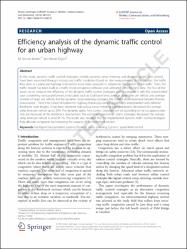| dc.contributor.author | Kesten, Ali Sercan | en_US |
| dc.contributor.author | Ergün, Murat | en_US |
| dc.date.accessioned | 2019-08-31T12:10:23Z | |
| dc.date.accessioned | 2019-08-05T16:03:02Z | |
| dc.date.available | 2019-08-31T12:10:23Z | |
| dc.date.available | 2019-08-05T16:03:02Z | |
| dc.date.issued | 2015-03-07 | |
| dc.identifier.citation | Kesten, A. S. & Ergün, M. (2015). RETRACTED: Efficiency analysis of the dynamic traffic control for an urban highway (Retracted article. See 185, 2016). Eurasip Journal on Wireless Communications and Networking, 2015(1), 1-9. doi:10.1186/s13638-015-0287-4 | en_US |
| dc.identifier.issn | 1687-1499 | |
| dc.identifier.uri | https://hdl.handle.net/11729/1757 | |
| dc.identifier.uri | https://dx.doi.org/10.1186/s13638-015-0287-4 | |
| dc.description.abstract | In this study, dynamic traffic control strategies, namely dynamic ramp metering and dynamic speed limit control, have been examined through microscopic traffic simulation based on site measurements. In this context, the traffic flow data at a particular highway intersection have been analyzed to determine the pattern of the traffic. Then, the traffic model has been built in a traffic micro-simulation software and calibrated with the field data. The foci of the study are to measure the efficiency of the dynamic traffic control strategies and to compare it with the uncontrolled case considering various performance indicators such as total travel time, average delay time per vehicle, and average number of stops per vehicle. For the dynamic ramp metering strategies, the ALINEA (Asservissement Lineaire d'Entree Autoroutiere - French for Linear Utilization for Highway Entrances) control algorithm is implemented with different fixed-time cycle lengths. It has been observed that various ramp metering implementations decreased the average delay time per vehicle up to 30%. The dynamic speed limit control strategies are set according to the occupancy rates that are measured at the bottleneck downstream. The examined speed limit control strategies decreased the average delay time per vehicle to around 7%. The results also revealed that the implemented dynamic traffic control strategies help alleviate congestion by increasing the capacity of the bottleneck section. | en_US |
| dc.description.sponsorship | Ministry of Education, Culture, Sports, Science & Technology of Japan | en_US |
| dc.description.sponsorship | The first author would like to thank PTV Japan for providing the license key of PTV VISSIM. The Ministry of Education, Culture, Sports, Science & Technology of Japan supported the PhD research of the first author. | en_US |
| dc.language.iso | eng | en_US |
| dc.publisher | Springer International Publishing AG | en_US |
| dc.relation.isversionof | 10.1186/s13638-015-0287-4 | |
| dc.rights | info:eu-repo/semantics/openAccess | en_US |
| dc.subject | Dynamic ramp metering | en_US |
| dc.subject | Dynamic speed limit control | en_US |
| dc.subject | Intelligent transportation systems | en_US |
| dc.title | RETRACTED: Efficiency analysis of the dynamic traffic control for an urban highway (Retracted article. See 185, 2016) | en_US |
| dc.type | article | en_US |
| dc.description.version | Publisher's Version | en_US |
| dc.relation.journal | EURASIP Journal on Wireless Communications
and Networking | en_US |
| dc.contributor.department | Işık Üniversitesi, Mühendislik Fakültesi, İnşaat Mühendisliği Bölümü | en_US |
| dc.contributor.department | Işık University, Faculty of Engineering, Department of Civil Engineering | en_US |
| dc.contributor.authorID | 0000-0001-8522-3382 | |
| dc.identifier.volume | 2015 | |
| dc.identifier.issue | 1 | |
| dc.identifier.startpage | 1 | |
| dc.identifier.endpage | 9 | |
| dc.peerreviewed | Yes | en_US |
| dc.publicationstatus | Published | en_US |
| dc.relation.publicationcategory | Makale - Uluslararası Hakemli Dergi - Kurum Öğretim Elemanı | en_US |
| dc.contributor.institutionauthor | Kesten, Ali Sercan | en_US |
| dc.relation.index | WOS | en_US |
| dc.relation.index | Scopus | en_US |
| dc.relation.index | Science Citation Index Expanded (SCI-EXPANDED) | en_US |
| dc.description.quality | Q3 | |
| dc.description.wosid | WOS:000351748600001 | |


















